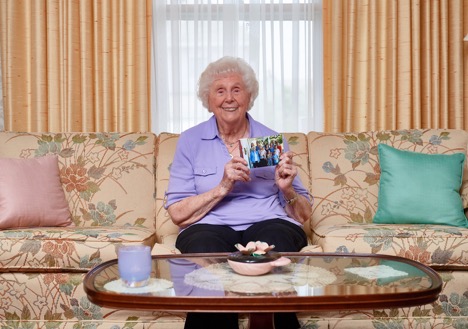MyCode's 101-year-old participant
Born in Scranton 50 years after Mendel, she was in her 90s by the time the genomics revolution led to Geisinger’s MyCode
Ruth Richards waited nearly 100 years to be part of the genomics revolution, but she got there.
An Augustinian monk and gardener named Gregor Mendel set out the basic principles of genetics, which he learned while cross-breeding pea plants, in 1866 — exactly 50 years before Ruth Richards of Scranton, Pennsylvania was born.
By the time baby Ruth was born in 1916, Mendel’s theories on genetics had begun to be taken up seriously within the scientific community.
But it would still be many years before “genetics” would become common parlance; and more still before it had any kind of everyday application.
Ruth would grow well into adulthood and celebrate her 37th birthday by the time Francis Crick and James Watson had discovered the double helix structure of DNA in 1953.
By the time the first complete human genome had been sequenced or decoded – after another 50 years, in 2003 – Mrs. Richards was already in her late 80s.
The idea of someone studying her own DNA – and potentially giving her medical advice based on it – was the furthest thing from her mind, and, we can only imagine, from Friar Mendel’s.
It wasn’t until 10 more years had passed, when Mrs. Richards was in her mid-90s, that she was approached in the waiting room of her doctor’s office about the opportunity to donate her DNA to a Geisinger research project, known as the MyCode Community Health Initiative.
At first, she said, ‘No.’ But then she asked her doctor about it and he said, given her longevity, it might be helpful to others to have her DNA studied, so she had a change of heart and signed up.
There is no known longevity gene, but lots of people are looking for one, or, more likely, multiple genes.
Genetic secrets of the well elderly – the “wellderly” – are, or have been the targets of some researchers, such as entrepreneur and genomic pioneer J. Craig Venter, whose company, Human Longevity Inc., is focused on extending healthy lifespans.
One Boston University study identified genetic variants associated with longevity and with reduced risks for cardiovascular and Alzheimer's disease.
Some of our own research, with our collaborators at Regeneron, has found that people with certain mutations in a gene known as ‘ANGPTL3’ are up to 41 percent less likely to get coronary artery disease.
The finding could lead to new drugs that mimic the effect of these gene mutations and lower the risk of coronary artery disease, thereby extending life.
But the science on genomics and longevity is far from established and the search continues.
As for Mrs. Richards, she said she doesn’t know of any secret to her longevity.
“My brother always said I got all the good genes,” Mrs. Richards said. “People say to me all the time: ‘How come you lived so long?’ And I don’t know. Nobody in my family has lived as long. My brother and sister both died in their early 80s,” she said.
Retired after 40 years of working as a math instructor at the International Correspondence Schools in Scranton, Mrs. Richards turns 102 years old in 2018. That makes her one of the oldest participants in the MyCode Community Health Initiative.
With minimal support, she takes care of herself in her own home; still drives a car and travels alone across country to visit her daughter. She’s active in a sewing group and plays cards once a month.
“You have to keep going. That’s all,” Mrs. Richards said. And so, she has.
Between the time Mendel promulgated his basic tenets of genetics and the time Mrs. Richards gave her blood for extraction and study of her own DNA to the MyCode Community Health Initiative, nearly 150 years passed — and Mrs. Richards has been around for more than 100 of them.
Today, Geisinger is routinely informing patients about some 27 genetic disorders, mainly cancers and heart disease, that they are at risk for because of their individual genetic makeup – medical advances only dreamed of for most of Mrs. Richards’ life.
In some cases, this information has become available before the patient has any symptoms. In some cases, it has been life-saving.
With more than 150,000 volunteers joining Mrs. Richards in donating their DNA for research study, imagine where we will go in the next 150 years!
Mendel, the monk, would be astonished at what he started and at what we have achieved together.
Thank you, Mrs. Richards, and all of you – young and old alike – for participating in the march of science.

